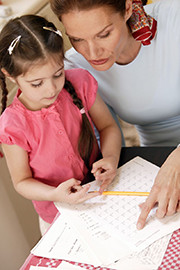What is it?
A learning disability is a neurological disorder that affects the person throughout life. It affects processes involved in understanding or in using language, spoken or written, that may look like imperfect ability to listen, think, read, speak write, spell or do math calculations. Simply put, a learning disability results from a difference in the way a person's brain is "wired." Children with learning disabilities are as smart, or smarter, than their peers, but they may have difficulty reading, writing, spelling, reasoning, recalling and/or organizing information. Fifteen percent of the U.S. population, or one in seven Americans, has some type of learning disability, according to the National Institutes of Health. Learning disabilities often run in families. Common learning disabilities involve reading, math calculations, writing, and organizational skills. One person will not have learning disabilities in all of these areas, but maybe affected by more than one. These are as follows:

- Dyslexia - a language-based disability in which a person has trouble understanding written words. It may also be referred to as reading disability or reading disorder.
- Dyscalculia - a mathematical disability in which a person has a difficult time solving arithmetic problems and grasping math concepts.
- Dysgraphia - a writing disability in which a person finds it hard to form letters or write within a defined space.
- Auditory and Visual Processing Disorders - sensory disabilities in which a person has difficulty understanding language despite normal hearing and vision.
- Nonverbal Learning Disabilities - a neurological disorder which originates in the right hemisphere of the brain, causing problems with visual-spatial, intuitive, organizational, evaluative and holistic processing functions. What does it look like in the classroom?
The most common learning disabilities show in the classroom as difficulty with basic reading and language skills. As many as 80% of students with learning disabilities have reading problems.
- Learning disabilities should not be confused with other disabilities such as autism, intellectual disability, deafness, blindness, and behavioral disorders. None of these conditions are learning disabilities. In addition, they should not be confused with lack of educational opportunities like frequent changes of schools or attendance problems. Also, children who are learning English do not necessarily have a learning disability.
- Attention disorders, such as Attention Deficit/Hyperactivity Disorder (ADHD) and learning disabilities often occur at the same time, but the two disorders are not the same.
Learning Support
With the right accommodations, interventions, and support children with learning disabilities can succeed in school and become successful adults in distinguished careers. These supports must be tailored to the needs of the students, which are generally identified by a school professional. Parents can help children with learning disabilities achieve such success by encouraging their strengths, knowing their weaknesses, understanding the educational system, learning about strategies for dealing with specific difficulties, and helping their children to self-advocate.
References and websites on this subject
United States
ldonline.org
naset.org
nichcy.org
ldaamerica.org
United Kingdom
Australia
cyh.com
raisingchildren.net.au
dyslexia-australia.com.au
These sites discuss mild, moderate, and severe learning disability.
sess.ie mild
sess.ie moderate
sess.ie severe
Canada
New Zealand
speld.org.nz
kiwifamilies.co.nz
ldonline.org, ldonline.org/ldbasics/whatisld